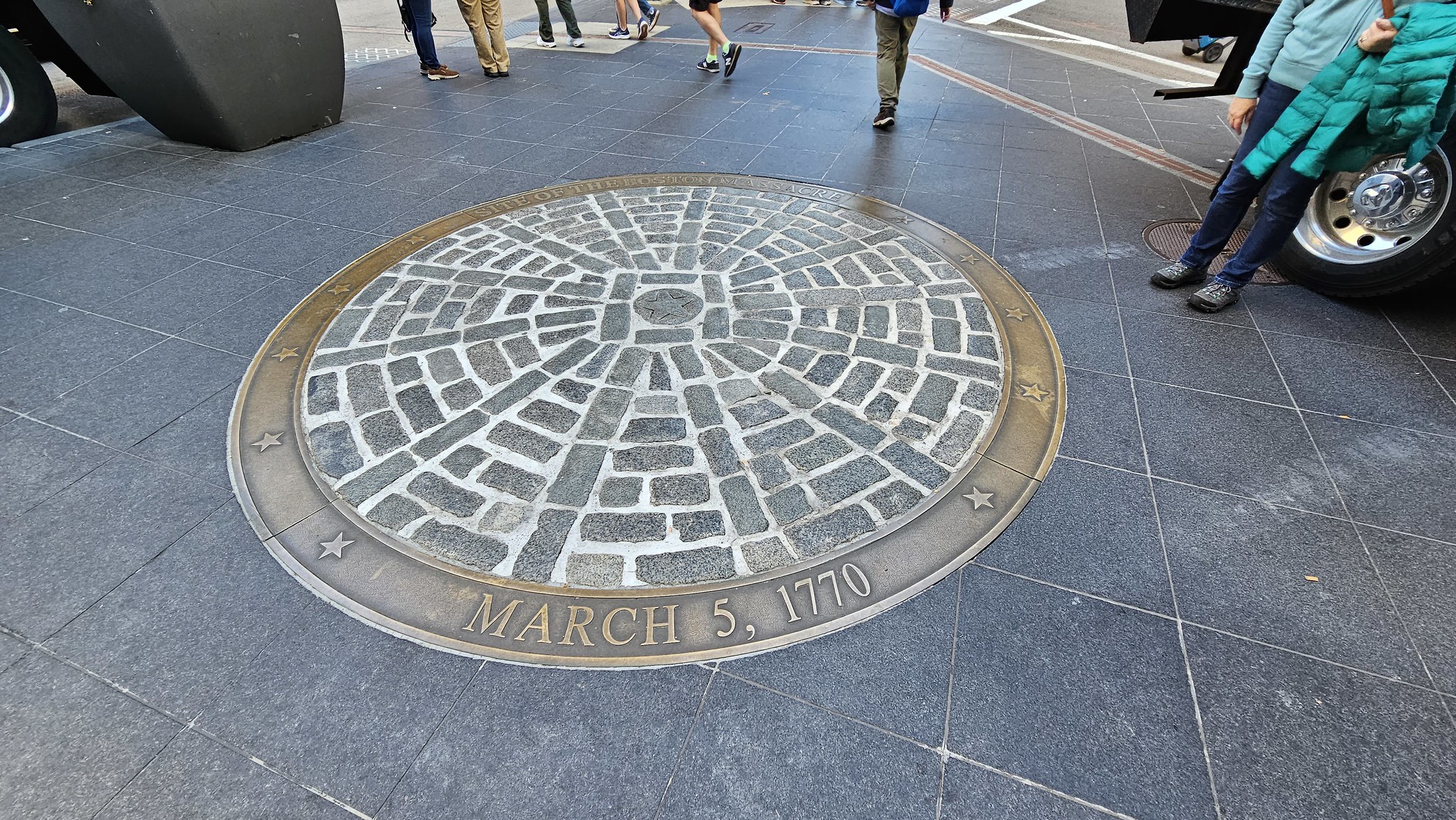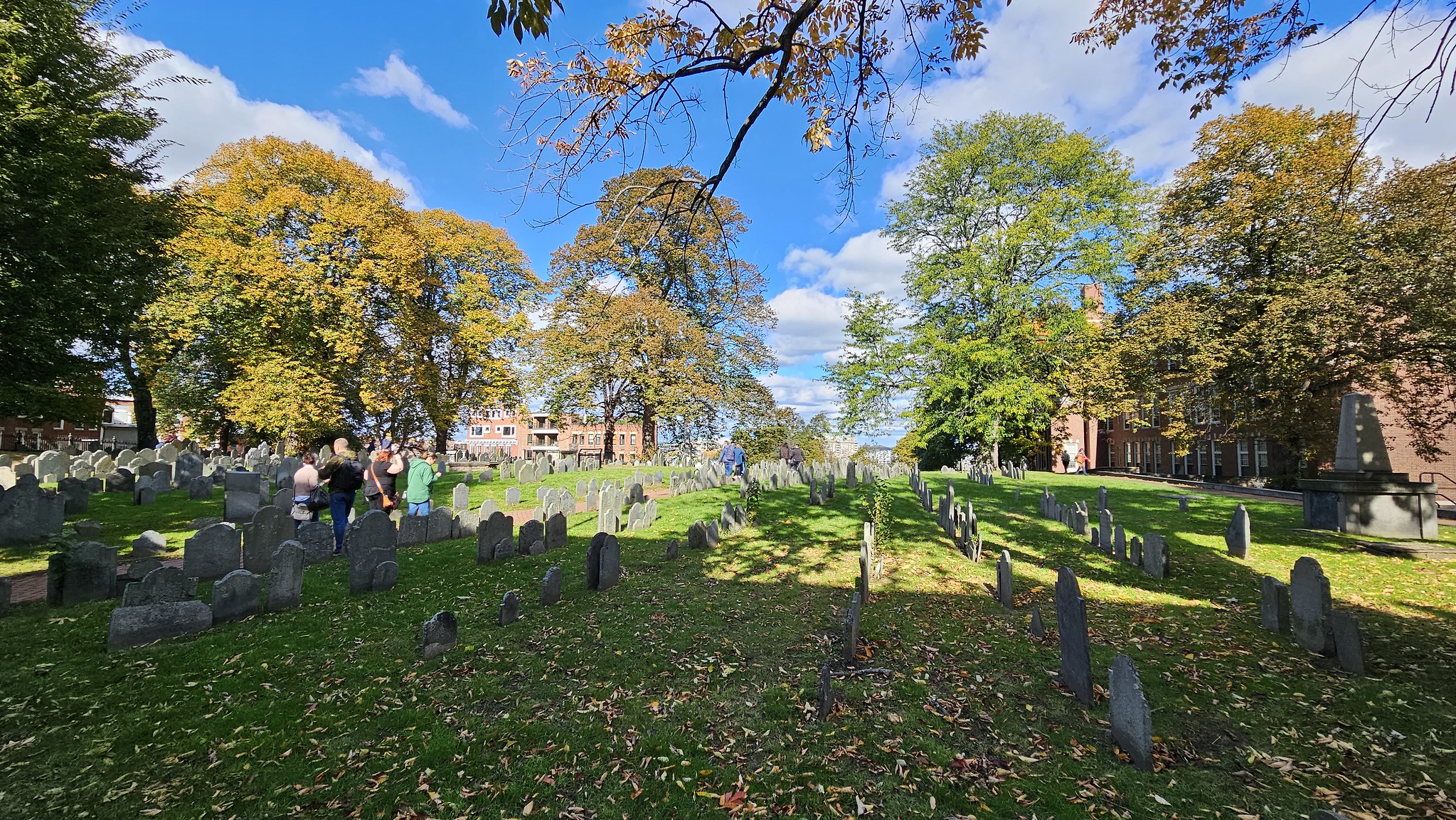

Review of The Freedom Trail in Boston
By Nige
on October 23, 2023
at 9:39 pm
Type: Post
Story: Holiday to New England in Oct 2023
Category: Travel
Tags: BOS | Boston | Hilton | Holidays | LHR | London Heathrow | Massachusetts | New England | USA
The Boston Freedom Trail is a 2.5-mile-long red-brick-lined path through Boston that passes by a number of significant locations that led set out the future of the United States.
It starts at the Tourist Information building on Boston Common, to the Bunker Hill and on to USS Constituion.


We enjoyed the trail in October in the fall.
Stops along the trail include simple explanatory ground markers, graveyards, notable churches and buildings, and the USS Constitution, which is a naval ship.
Most of the sites are free or take donations, although some charge a small admission.
It was a little chilly, but the sun was still warm. So we were pleased we came with light coats to keep us warm.
[insert-clear-float]
1. Boston Common Tourist Information


Firstly, Boston Common is a beautiful park for taking in the sights of the colourful trees.
Secondly, it’s the start of the Freedom Trail, at the Tourist Information building, where tourists can pick up maps and guided and self-guided tours, so that you can get the most out of walking the Freedom Trail.
From here, we headed NNW up to Beacon Street and the Massachusettes State House.
[insert-clear-float]
2. Massachusettes State House


The State House is the next stop on the Freedom Trail and it’s located on top of Beacon Hill.
It’s a beautiful and impressive-looking building, one that Boston locals must be very proud of.
The bottom of the steps is a popular location for taking photos.
From here, we headed SSE following Park Street but staying inside Boston Common to Park Street Church.
[insert-clear-float]
3. Park Street Church


Another impressive-looking building on the Freedom Trail.
The founding of the church is dated to 1804 when the Religious Improvement Society began weekly meetings with lectures and prayer.
The church’s cornerstone was laid on 1st May 1809, with construction being completed the same year, under the guidance of the architect, Peter Banner, the chief mason, Benajah Young and a woodcarver, Solomon Willard.
It’s easy to miss on the way to Granary Burying Ground which we reached by walking NE along Tremonth Street.
[insert-clear-float]
4. Granary Burying Ground


The Granary Burying Ground in Boston is the third-oldest cemetery, founded in 1660. It’s the final resting place for a number of key people including Paul Revere, Samuel Adams, John Hancock, and Robert Treat Paine. The cemetery has 2,345 grave-markers.
Next stop for us was King’s Chapel and King’s Burying Ground, which we found continuing up Tremont Street to School Street, then crossing over the road.
Remember following the red brick path helps keep you on track!
[insert-clear-float]
5. King’s Chapel and King’s Burying Ground


King’s Chapel was founded in 1686 as the first Anglican Church in colonial New England during the reign of King James II. It was originally a wooden structure.
In 1749, construction began on the current stone structure, designed by Peter Harrison and completed in 1754.
Interestingly, the King’s Chapel Burying Ground is not affiliated with the chapel of the same name; it pre-dates the present church by over a century.
[insert-clear-float]
6. Boston Latin School/Benjamin Franklin Statue


Boston Latin School was founded on 23rd April 1635. The school was modeled after the Free Grammar School of Boston in England under the influence of Reverend John Cotton.
A statue of Benjamin Franklin by Richard Saltonstall Greenough is installed outside Old City Hall.
We didn’t specifically catch either of these, but we did see the beautiful Old City Hall.
Next stop was the Old Corner store, just down at the bottom of School Street.
[insert-clear-float]
7. Old Corner Bookstore


The Old Corner Bookstore is a historic commercial building, built in 1718 as a residence and apothecary shop. It became a bookstore in 1828 and is now a restaurant.
There’s a nice photo opportunity from the nearby memorial.
Next stop was the Old South Meeting House which is just a stones-throw away on Washington Street.
[insert-clear-float]
8. Old South Meeting House


The Old South Meeting House is a historic Congregational church, built in 1729.
It is significant as the meeting place for the Boston Tea Party on 16th December 1773.
Five thousand gathered at the Old South Meeting House, which was the largest building in Boston at the time.
Next stop for us was the Old State House, which can be found heading north at the junction of Washington Street and State Street.
[insert-clear-float]
9. Old State House


Built in 1713, the Old State House as the seat of the Massachusetts General Court until 1798.
Apparently, it is the oldest surviving public building in Boston.
It’s a beautifully well preserved building but it’s challenging finding the best view to take a photo from.
Next stop was the Boston Massacre Site,
[insert-clear-float]
10. Boston Massacre Site


The Boston Massacre (also known as the Incident on King Street) was a confrontation on 5th March 1770, when nine British soldiers shot several of a crowd of three or four hundred.
The incident was publicized as a massacre by leading Patriots Paul Revere and Samuel Adams.
King Street is now known as State Street, so the background to the incident might confuse locating this site.
We didn’t spend any time here; we carried on to Faneuil Hall, which can found heading N along Congress Street.
[insert-clear-float]
11. Faneuil Hall


Faneuil Hall is a marketplace and meeting hall located near the waterfront. It was opened in 1742 and was the site of several speeches by Samuel Adams (famous for his Boston Lager?).
It is now part of Boston National Historical Park and is sometimes referred to as the Cradle of Liberty.
We walked down to right hand side to find Quincy Market (behind Faneuil Hall), where we found a pavement entertainer juggling knives!
Next stop was Paul Revere House, which is a fair walk NE from Faneuil Hall.
[insert-clear-float]
12. Paul Revere House


After a good walk, we found Paul Revere House. We saw lots of people hanging around North Square, which is a pretty little area of Boston.
The Paul Revere House was built in 1680 and was the colonial home of American patriot and Founding Father Paul Revere. This has been a National Historic Landmark since 1961 and is now operated as a non-profit museum.
We didn’t bother paying the admission fee to look around inside, but it’s a nice-looking building from the outside.
Next stop was Old North Church which we reached by heading NE along Hanover Street until we reached St Stephen’s Church on the right hand side. Directly opposite is a pedestrian area which took us to Old North Church.
[insert-clear-float]
13. Old North Church


The Old North Church is an Episcopal church, built in 1723 and is the oldest standing church building in Boston and is officially a National Historic Landmark.
It is renowned for its role in Paul Revere’s midnight ride on 18th April 1775, when the church’s sexton hung two lanterns in the church’s steeple.
That informed Revere and the other riders about British military movements prior to the Battles of Lexington and Concord, the first engagements of the American Revolutionary War.
Next stop for us was Copp’s Hill Burying Ground, which was just up Hull Street opposite the front of Old North Church.
[insert-clear-float]
14. Copp’s Hill Burying Ground


Copp’s Hill Burying Ground is a cemetery established in 1659, which was originally named North Burying Ground – it was the city’s second cemetery.
Vick started referring to these burying grounds as Big Cheese Graveyards, which I think aptly describes them.
Next stop was across the Charles River. When we walked over there was a lot of road works and we were forced across to the far side of the bridge.
[insert-clear-float]
15. Bunker Hill Monument


The Bunker Hill Monument is erected at the site of the Battle of Bunker Hill, which was among the first major battles between the Red Coats and Patriots in the American Revolutionary War.
It is 221-foot tall, made out of granite and was erected between 1825 and 1843.
Apparently, there are 294 steps to the top, not that we got the chance to count them!
When we arrived at Bunker Hill, it was being renovated, so there was scaffolding around it, so nothing much to look at. It also meant it wasn’t possible to head up the tower to check out the views.
We were starting to struggle re tiredness and we were also getting a tad warm. It was still an enjoyable walk though.
Final stop for us was the USS Constitution, which meant a bit of back-tracking, before heading SE to the USS Constitution Visitors’ Center.
[insert-clear-float]
16. USS Constitution


The USS Constitution was also known as Old Ironsides and is a three-masted wooden-hulled heavy frigate of the United States Navy.
She is the world’s oldest commissioned naval warship still afloat and was launched in 1797. The third of six original frigates constructed under the Naval Act of 1794.
We didn’t bother walking around the ship but it looked mighty impressive.
[insert-clear-float]
Overall, the Freedom Trail is a worthy opportunity to walk the streets of Boston, finding out much about the significance of the 16 sites in US history.

Leave A Comment